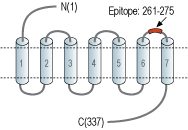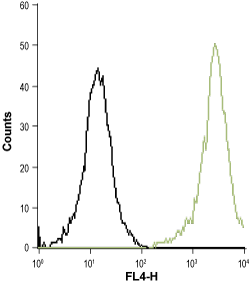Overview
- Peptide (C)HNETKP(S)DSVLRMQK, corresponding to amino acid residues 261-275 of human CysLTR1 (Accession Q9Y271). 3rd extracellular loop.

 Western blot analysis of acute monocytic leukemia THP-1 (lanes 1 and 4), promyelocytic leukemia HL-60 (lanes 2 and 5) and acute T-cell leukemia Jurkat (lanes 3 and 6) human cell lysates:1,2,3. Anti-CysLTR1 (extracellular) Antibody (#ALR-003), (1:200).
Western blot analysis of acute monocytic leukemia THP-1 (lanes 1 and 4), promyelocytic leukemia HL-60 (lanes 2 and 5) and acute T-cell leukemia Jurkat (lanes 3 and 6) human cell lysates:1,2,3. Anti-CysLTR1 (extracellular) Antibody (#ALR-003), (1:200).
4,5,6. Anti-CysLTR1 (extracellular) Antibody, preincubated with CysLTR1 (extracellular) Blocking Peptide (#BLP-LR003).
- Rovati, G.E. and Capra, V. (2007) ScientificWorldJournal 7, 1375.
- Samuelson, B. (1983) Science 220, 568.
- Funk, C.D. (2001) Science 294, 1871.
- Singh, R.K. et al. (2010) Pharmacology 85, 336.
- Kanaoka, Y. and Boyce, J.A. (2004) J. Immunol. 173, 1503.
- Capra, V. et al. (2006) Med. Res. Rev. 27, 469.
LTC4, LTD4, and LTE4 are leukotrienes (cys-LTs) derived from arachidonic acid as a result of immune or inflammatory stimuli1-3.
The above mentioned cys-LTs bind and activate two receptors belonging to the G-protein coupled receptor superfamily, CysLTR1 and CysLTR2 (also named cysLT1 and cysLT2 respectively). There is evidence though that other receptors are yet to be identified4. These two receptors couple to both pertussis toxin sensitive (Gi/o) and insensitive (Gq, which initiates Ca2+ influx) G-proteins for their signaling. The G-protein coupled to is probably determined by which ligand binds the receptor as all three cys-LTs can activate the two receptors albeit with different affinities5. In mouse, CysLTR1 and CysLTR2 are subject to alternative splicing. CysLTR1 receptor expresses greater affinity for LTD4 and binds equally to LTC4 and LTE4 whereas CysLTR2 has greater and equal affinity towards LTC4 and LTD4 over LTE45.
Human CysLTR1 is highly expressed in spleen, peripheral blood, leukocytes. It is less strongly expressed in lung, small intestine, pancreas and hardly or not expressed in liver, colon, kidney, skeletal muscle, testis heart and brain4. On the other hand, CysLTR2 is highly expressed in spleen and leukocytes. Its expression in the heart, brain, spinal cord and adrenal gland differs it from that of CysLTR14.
Cys-LTs and their receptors are involved in respiratory diseases like asthma and other conditions such as cancer cardiovascular, gastrointestinal, skin and immune disorders1,6.
Application key:
Species reactivity key:
Anti-CysLTR1 (extracellular) Antibody (#ALR-003) is a highly specific antibody directed against an epitope of the human protein. The antibody can be used in western blot and indirect live cell flow cytometry applications. It has been designed to recognize CysLTR1 from human, mouse, and rat samples.

